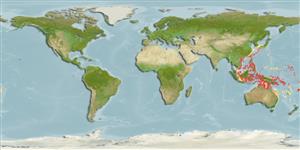>
Syngnathiformes (Pipefishes and seahorses) >
Syngnathidae (Pipefishes and seahorses) > Nerophinae
Etymology: Dunckerocampus: From Duncker, an ichthyologist and taxonomist that recognized four Gobiidae families (1928) + Gr, kampe = bent; naia: Name after the Fiji-based dive vessel Nai’a; noun in apposition.
Eponymy: Dr Paul Georg Egmont Duncker (1870–1953) was a German zoologist and ichthyologist. [...] Nai’a was the name of the Fiji-based dive vessel from which specimens were collected. (Ref. 128868), visit book page.
Environment: milieu / climate zone / depth range / distribution range
Écologie
marin démersal; profondeur 15 - 40 m (Ref. 90102). Tropical
Pacific Ocean: Japan, Guam, Indoensia, Fiji and Solomon Islands.
Taille / Poids / Âge
Maturity: Lm ? range ? - ? cm
Max length : 12.0 cm SL (female)
Description synthétique
Clés d'identification | Morphologie | Morphométrie
Rayons mous dorsaux (Total) : 20 - 21; Rayons mous anaux: 4. This species has the following characters: 17 + 19 rings; 20-21 dorsal fin rays; 3.5 subdorsal rings; 20 pectoral fin rays; head length 4.2-4.3 in SL; snout length 1.6-1.7 in HL; colour pattern with 24-31 alternating pale yellowish to white and maroon bars; caudal fin mainly red with broad white upper and lower margins (Ref. 77036).
Male carries the eggs in a brood pouch (Ref. 205). Solitary or in pairs in caverns or under ledges in 15-40 m (Ref 90102).
Life cycle and mating behavior
Maturité | Reproduction | Frai | Œufs | Fécondité | Larves
Male carries the eggs in a brood pouch (Ref. 205).
Allen, G.R. and R.H. Kuiter, 2004. Dunckeroncampus naia, a new pipefish (Pisces: Syngnathidae) from the Western Pacific. aqua, J. Ichthyol. Aquat. Biol. 9(1):1-6. (Ref. 77036)
Statut dans la liste rouge de l'IUCN (Ref. 130435: Version 2024-2)
Menace pour l'homme
Harmless
Utilisations par l'homme
Outils
Articles particuliers
Télécharger en XML
Sources Internet
Estimates based on models
Preferred temperature (Ref.
123201): 25.5 - 28.9, mean 27.7 °C (based on 98 cells).
Phylogenetic diversity index (Ref.
82804): PD
50 = 0.5078 [Uniqueness, from 0.5 = low to 2.0 = high].
Bayesian length-weight: a=0.00093 (0.00036 - 0.00242), b=3.05 (2.83 - 3.27), in cm total length, based on LWR estimates for this (Sub)family-body shape (Ref.
93245).
Niveau trophique (Ref.
69278): 3.7 ±0.6 se; based on size and trophs of closest relatives
Résilience (Ref.
120179): Haut, temps minimum de doublement de population inférieur à 15 mois (Preliminary K or Fecundity.).
Fishing Vulnerability (Ref.
59153): Low vulnerability (10 of 100).
